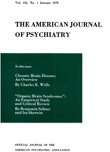233 PATIENTS WITH MENTAL ILLNESS TREATED WITH ELECTROCONVULSIVE THERAPY IN THE PRESENCE OF TUBERCULOSIS
Abstract
1. In 160 patients with active pulmonary tuberculosis who received ECT, no extensive hematogenous spreads such as miliary or meningeal tuberculosis and no involvement of remote organs occurred.
2. In 21.3% of patients with active pulmonary tuberculosis, the tuberculosis became worse, but there was a high degree of probability that it would not do so if the mental condition improved from ECT, or if the disease was less than far advanced, and if Sputum was negative; and it probably was less likely to become worse in persons over 35 years old. Race and sex appeared to have no definite effect. However, when ECT did not cause symptomatic improvement there was a better-than-50% chance that the tuberculosis would get worse.[SEE FIG 1 TO 6 IN SOURCE PDF]
3. In each group, those whose tuberculosis got worse and those in whom it did not, 66% had 19 or more ECT treatments. There appeared to be no causal relationship between spread of tuberculosis and number of treatments.
4. When there was a spread of tuberculosis, it was usually not very extensive and could be easily managed if the patient had become cooperative.
5. Patients with arrested or inactive tuberculosis did not have more breakdowns when given ECT.
6. The death rate in this series was not increased by the ECT.
7. No special precautions such as curare or routine administration of antituberculous drugs were used and patients with pneumothorax, pneumoperitoneum, recent thoracoplasty, or excisional surgery were treated without harmful effect.
8. Antituberculous drugs were relatively ineffective in preventing or treating spread of tuberculosis in disturbed patients, but were very useful in treating spreads which occurred during or after ECT, especially if the patient's behavior and mental condition had improved.
Access content
To read the fulltext, please use one of the options below to sign in or purchase access.- Personal login
- Institutional Login
- Sign in via OpenAthens
- Register for access
-
Please login/register if you wish to pair your device and check access availability.
Not a subscriber?
PsychiatryOnline subscription options offer access to the DSM-5 library, books, journals, CME, and patient resources. This all-in-one virtual library provides psychiatrists and mental health professionals with key resources for diagnosis, treatment, research, and professional development.
Need more help? PsychiatryOnline Customer Service may be reached by emailing [email protected] or by calling 800-368-5777 (in the U.S.) or 703-907-7322 (outside the U.S.).



